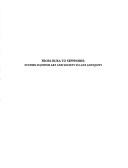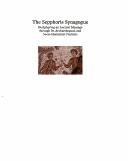| Listing 1 - 10 of 11 | << page >> |
Sort by
|
Book
ISBN: 9780674048317 0674048318 0674726626 0674728017 9780674726628 Year: 2014 Volume: 21 Publisher: Cambridge, MA : Harvard University Press,
Abstract | Keywords | Export | Availability | Bookmark
 Loading...
Loading...Choose an application
- Reference Manager
- EndNote
- RefWorks (Direct export to RefWorks)
Public Spectacles in Roman and Late Antique Palestine introduces readers to the panoply of public entertainment that flourished in Palestine from the first century BCE to the sixth century CE. Drawing on a trove of original archaeological and textual evidence, Zeev Weiss reconstructs an ancient world where Romans, Jews, and Christians intermixed amid a heady brew of shouts, roars, and applause to watch a variety of typically pagan spectacles. Ancient Roman society reveled in many such spectacles--dramatic performances, chariot races, athletic competitions, and gladiatorial combats--that required elaborate public venues, often maintained at great expense. Wishing to ingratiate himself with Rome, Herod the Great built theaters, amphitheaters, and hippodromes to bring these forms of entertainment to Palestine. Weiss explores how the indigenous Jewish and Christian populations responded, as both spectators and performers, to these cultural imports. Perhaps predictably, the reactions of rabbinic and clerical elites did not differ greatly. But their dire warnings to shun pagan entertainment did little to dampen the popularity of these events. Herod's ambitious building projects left a lasting imprint on the region. His dream of transforming Palestine into a Roman enclave succeeded far beyond his rule, with games and spectacles continuing into the fifth century CE. By then, however, public entertainment in Palestine had become a cultural institution in decline, ultimately disappearing during Justinian's reign in the sixth century.
Entertainment events --- Popular culture --- Romans --- Spectacles et divertissements --- Culture populaire --- Romains --- History --- Histoire --- Palestine --- Social life and customs. --- Antiquities, Roman. --- Antiquities. --- Moeurs et coutumes --- Antiquités romaines --- Antiquités --- Römerzeit. --- Spektakel. --- Spätantike. --- History. --- Palästina. --- Architecture, Roman --- Antiquities, Roman --- Antiquités romaines --- Antiquités --- Social life and customs --- Antiquities --- Culture, Popular --- Mass culture --- Pop culture --- Popular arts --- Communication --- Intellectual life --- Mass society --- Recreation --- Culture --- Amusements --- Holy Land --- Entertainment events - Palestine - History --- Popular culture - Palestine - History --- Romans - Palestine --- Architecture, Roman - Palestine --- Palestine - Social life and customs --- Palestine - Antiquities, Roman --- Palestine - Antiquities --- Palestine - History - To 70 A.D. --- Palestine - History - 70-638
Book
ISBN: 9789652210975 9652210978 9789652211088 9789652211170 9789652211279 Year: 2015 Publisher: Jerusalem: Israel exploration society,
Abstract | Keywords | Export | Availability | Bookmark
 Loading...
Loading...Choose an application
- Reference Manager
- EndNote
- RefWorks (Direct export to RefWorks)
Excavations (Archaeology) --- Fouilles (Archéologie) --- Palestine --- Middle East --- Moyen-Orient --- Antiquities. --- Antiquités --- Inscriptions, Ancient --- Israel --- Historical geography. --- Bible. --- Criticism, interpretation, etc.
Digital
ISBN: 9780674726628 9780674048317 Year: 2014 Publisher: Cambridge, Mass. Harvard University Press
Abstract | Keywords | Export | Availability | Bookmark
 Loading...
Loading...Choose an application
- Reference Manager
- EndNote
- RefWorks (Direct export to RefWorks)
Book
Year: 2025 Publisher: Jerusalem : Israel Exploration Society,
Abstract | Keywords | Export | Availability | Bookmark
 Loading...
Loading...Choose an application
- Reference Manager
- EndNote
- RefWorks (Direct export to RefWorks)
Book
ISBN: 9789004215344 9789004217447 Year: 2012 Volume: 78 Publisher: Leiden ;Boston Brill
Abstract | Keywords | Export | Availability | Bookmark
 Loading...
Loading...Choose an application
- Reference Manager
- EndNote
- RefWorks (Direct export to RefWorks)
Judaism --- Jews --- Judaïsme --- Juifs --- History --- Congresses --- Histoire --- Congrès --- Temple of Jerusalem (Jerusalem) --- 933.4 --- Hebrews --- Israelites --- Jewish people --- Jewry --- Judaic people --- Judaists --- Ethnology --- Religious adherents --- Semites --- Religions --- Geschiedenis van het Joodse volk: diaspora in de Tweede Tempelperiode--(538 v.Chr.-70 n.Chr.) --- Religion --- 933.4 Geschiedenis van het Joodse volk: diaspora in de Tweede Tempelperiode--(538 v.Chr.-70 n.Chr.) --- Judaïsme --- Congrès --- Congresses.
Book
ISBN: 9782503553351 Year: 2017 Volume: 6 Publisher: Turnhout Brepols
Abstract | Keywords | Export | Availability | Bookmark
 Loading...
Loading...Choose an application
- Reference Manager
- EndNote
- RefWorks (Direct export to RefWorks)
Public worship --- History --- Palestine --- Middle East --- Moyen-Orient --- Religion --- Religious life and customs --- Vie religieuse --- Histoire --- Excavations (Archaeology) --- Antiquities --- Religious life and customs. --- History.
Book
ISBN: 1575066254 9781575066257 9781575062006 1575062003 Year: 2010 Publisher: Winona Lake, Ind. : Eisenbrauns,
Abstract | Keywords | Export | Availability | Bookmark
 Loading...
Loading...Choose an application
- Reference Manager
- EndNote
- RefWorks (Direct export to RefWorks)
In 1961, when Lee Israel Levine graduated from both Columbia College in New York, majoring in philosophy, and Jewish Theological Seminary, majoring in Talmud, this accomplishment was only a precursor to the brilliant career that would follow. While researching his Columbia University dissertation in Jerusalem, Levine established close ties with members of the Institute of Archaeology at Hebrew University and Prof. Yigael Yadin, who recognized the need for an interdisciplinary approach that would give graduate archaeology students a solid base in Jewish history and rabbinic sources to supplement their archaeological training. Levine accepted Yadin’s invitation to return to Israel after graduation to teach at the Institute of Archaeology and later was granted a joint appointment in the Institute of Archaeology and the Department of Jewish History. In 1985, he was promoted to the rank of Full Professor, and since 2003, he has held the Rev. Moses Bernard Lauterman Family Chair in Classical Archaeology at the Hebrew University.Levine was instrumental in founding and developing the TALI (an acronym for Tigbur Limudei Yahadut, Enriched Jewish Studies) track of Israel’s state school system. He was also a founding member of the Seminary of Judaic Studies in Jerusalem (now known as the Schechter Institute for Jewish Studies), which opened its doors in 1984. In addition to teaching, Lee headed the Schechter Institute (first as dean and then as president) from 1987 to 1994. Lee was an active member of the Masorti Movement in Israel and represented it abroad as Director of the Foundation for Masorti Judaism (1986–87) and Vice-Chancellor of Israel Affairs at the Jewish Theological Seminary (1987–94).The honoree has published 12 monographs, 11 edited or coedited volumes, and 180 articles. His scholarship encompasses a broad range of topics relating to ancient Judaism, especially archaeology, rabbinic studies, and Jewish history. Within these disciplines he has dealt with a variety of subfields, including ancient synagogues and liturgy, ancient Jewish art, Galilee, Jerusalem, Hellenism and Judaism, and the historical geography of ancient Palestine. He is one of the first major scholars to draw on and integrate data from all of these fields in order to afford a better understanding of ancient Judaism. The 32 contributions to this volume by 35 authors are a tribute to his influence on this field of study and reflect the broad spectrum of his own interests. The 26 English and 6 Hebrew essays are divided into sections on Hellenism, Christianity, and Judaism; art and archaeology—Jerusalem and Galilee; rabbis; the ancient synagogue; sages and patriarchs; and archaeology, art, and historical geography.
Judaism --- Jews --- Rabbinical literature --- Synagogues --- Jewish architecture --- Religious institutions --- Temples --- Hellenistic Judaism --- Judaism, Hellenistic --- History --- History and criticism. --- History. --- Palestine --- Antiquities. --- 296 <082> --- 933 --- 933 Geschiedenis van Palestina en het Joodse volk --- Geschiedenis van Palestina en het Joodse volk --- History and criticism --- Judaïsme. Jodendom--Feestbundels. Festschriften --- Festschrift - Libri Amicorum --- Synagogues. --- Rabbinical literature. --- Jews. --- Archaeological specimens --- Artefacts (Antiquities) --- Artifacts (Antiquities) --- Specimens, Archaeological --- Material culture --- Archaeology --- Hebrews --- Israelites --- Jewish people --- Jewry --- Judaic people --- Judaists --- Ethnology --- Religious adherents --- Semites --- Religions --- Hebrew literature --- Jewish literature --- Post-exilic period (Judaism) --- Religion --- Middle East --- Middle East. --- Orient --- Asia, South West --- Asia, Southwest --- Asia, West --- Asia, Western --- East (Middle East) --- Eastern Mediterranean --- Fertile Crescent --- Levant --- Mediterranean Region, Eastern --- Mideast --- Near East --- Northern Tier (Middle East) --- South West Asia --- Southwest Asia --- West Asia --- Western Asia --- Jewish question --- Eastern Mediterranean Region --- South West --- Asia --- Erets Israel --- Erets Yiśraʼel --- Eretz Israel --- Erez Jisrael --- Falastīn --- Filasṭīn --- Memshelet Paleśtinah --- Palästina --- Palesṭin --- Palestina --- Paleśtinah --- Israel
Book
ISBN: 1283356783 9786613356789 9004217444 9004215344 Year: 2012 Publisher: Leiden ; Boston : Brill,
Abstract | Keywords | Export | Availability | Bookmark
 Loading...
Loading...Choose an application
- Reference Manager
- EndNote
- RefWorks (Direct export to RefWorks)
The destruction of the Temple of Jerusalem in 70 CE, which put an end to sacrificial worship in Israel, is usually assumed to constitute a major caesura in Jewish history. But how important was it? What really changed due to 70? What, in contrast, was already changing before 70 or remained basically – or “virtually” -- unchanged despite it? How do the Diaspora, which was long used to Temple-less Judaism, and early Christianity, which was born around the same time, fit in? This Scholion Library volume presents twenty papers given at an international conference in Jerusalem in which scholars assessed the significance of 70 for their respective fields of specialization, including Jewish liturgy, law, literature, magic, art, institutional history, and early Christianity.
Judaism --- Jews --- History --- Temple of Jerusalem (Jerusalem)

ISBN: 1887829407 Year: 2000 Volume: 40
Abstract | Keywords | Export | Availability | Bookmark
 Loading...
Loading...Choose an application
- Reference Manager
- EndNote
- RefWorks (Direct export to RefWorks)
Pavements, Mosaic --- Synagogue art --- Synagogues --- History --- Sepphoris (Extinct city) --- Middle East --- Antiquities

ISBN: 9652210579 Year: 2005 Publisher: Jerusalem : Israel Exploration Society : Institute of Archaeology, Hebrew University of Jerusalem,
Abstract | Keywords | Export | Availability | Bookmark
 Loading...
Loading...Choose an application
- Reference Manager
- EndNote
- RefWorks (Direct export to RefWorks)
Synagogues --- Excavations (Archaeology) --- Mosaic floors --- Decoration and ornament, Architectural --- Fouilles (Archéologie) --- Planchers en mosaïque --- Décoration et ornement architecturaux --- Sepphoris (Extinct city) --- Israel --- Zippori (Israël) --- Israël --- Antiquities. --- Antiquités --- 726.3 --- 902 <33> --- 726.3 Synagogen. Joodse tempels --- Synagogen. Joodse tempels --- 902 <33> Archeologie--Oud-Palestina. Judea --- Archeologie--Oud-Palestina. Judea --- Floor mosaics --- Floors, Mosaic --- Floors --- Mosaics --- Pavements, Mosaic --- Archaeological digs --- Archaeological excavations --- Digs (Archaeology) --- Excavation sites (Archaeology) --- Ruins --- Sites, Excavation (Archaeology) --- Archaeology --- Architectural decoration and ornament --- Architecture --- Stonework, Decorative --- Architectural design --- Exterior walls --- Decoration and ornament --- Seffurieh (Extinct city) --- Sepphoris (Ancient city) --- Sepporis (Extinct city) --- Suffuriya (Extinct city) --- Tsipori (Extinct city) --- Tsiporim (Extinct city) --- Tsiporin (Extinct city) --- Tsippōrī (Extinct city) --- Ẓippori (Extinct city) --- Antiquities
| Listing 1 - 10 of 11 | << page >> |
Sort by
|

 Search
Search Feedback
Feedback About UniCat
About UniCat  Help
Help News
News